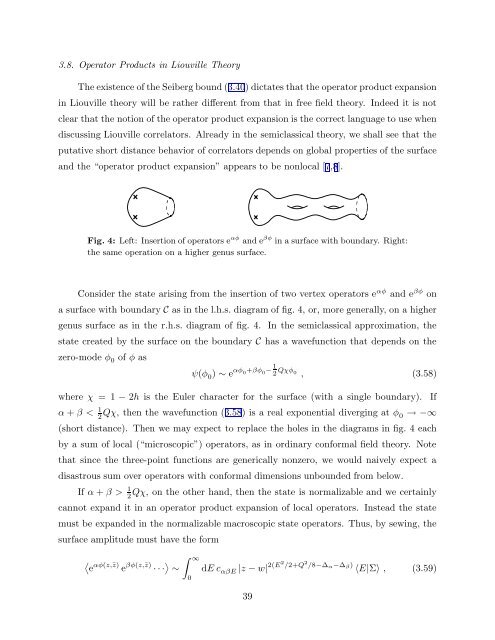arXiv:hep-th/9304011 v1 Apr 5 1993
arXiv:hep-th/9304011 v1 Apr 5 1993
arXiv:hep-th/9304011 v1 Apr 5 1993
Create successful ePaper yourself
Turn your PDF publications into a flip-book with our unique Google optimized e-Paper software.
3.8. Operator Products in Liouville Theory<br />
The existence of <strong>th</strong>e Seiberg bound (3.40) dictates <strong>th</strong>at <strong>th</strong>e operator product expansion<br />
in Liouville <strong>th</strong>eory will be ra<strong>th</strong>er different from <strong>th</strong>at in free field <strong>th</strong>eory. Indeed it is not<br />
clear <strong>th</strong>at <strong>th</strong>e notion of <strong>th</strong>e operator product expansion is <strong>th</strong>e correct language to use when<br />
discussing Liouville correlators. Already in <strong>th</strong>e semiclassical <strong>th</strong>eory, we shall see <strong>th</strong>at <strong>th</strong>e<br />
putative short distance behavior of correlators depends on global properties of <strong>th</strong>e surface<br />
and <strong>th</strong>e “operator product expansion” appears to be nonlocal [7,8].<br />
Fig. 4: Left: Insertion of operators e αφ and e βφ in a surface wi<strong>th</strong> boundary. Right:<br />
<strong>th</strong>e same operation on a higher genus surface.<br />
Consider <strong>th</strong>e state arising from <strong>th</strong>e insertion of two vertex operators e αφ and e βφ on<br />
a surface wi<strong>th</strong> boundary C as in <strong>th</strong>e l.h.s. diagram of fig. 4, or, more generally, on a higher<br />
genus surface as in <strong>th</strong>e r.h.s. diagram of fig. 4. In <strong>th</strong>e semiclassical approximation, <strong>th</strong>e<br />
state created by <strong>th</strong>e surface on <strong>th</strong>e boundary C has a wavefunction <strong>th</strong>at depends on <strong>th</strong>e<br />
zero-mode φ 0 of φ as<br />
ψ(φ 0 ) ∼ e αφ 0 +βφ 0 − 1 2 Qχφ 0 , (3.58)<br />
where χ = 1 − 2h is <strong>th</strong>e Euler character for <strong>th</strong>e surface (wi<strong>th</strong> a single boundary).<br />
α + β < 1 2 Qχ, <strong>th</strong>en <strong>th</strong>e wavefunction (3.58) is a real exponential diverging at φ 0 → −∞<br />
(short distance). Then we may expect to replace <strong>th</strong>e holes in <strong>th</strong>e diagrams in fig. 4 each<br />
by a sum of local (“microscopic”) operators, as in ordinary conformal field <strong>th</strong>eory. Note<br />
<strong>th</strong>at since <strong>th</strong>e <strong>th</strong>ree-point functions are generically nonzero, we would naively expect a<br />
disastrous sum over operators wi<strong>th</strong> conformal dimensions unbounded from below.<br />
If α + β > 1 2Qχ, on <strong>th</strong>e o<strong>th</strong>er hand, <strong>th</strong>en <strong>th</strong>e state is normalizable and we certainly<br />
cannot expand it in an operator product expansion of local operators. Instead <strong>th</strong>e state<br />
must be expanded in <strong>th</strong>e normalizable macroscopic state operators. Thus, by sewing, <strong>th</strong>e<br />
surface amplitude must have <strong>th</strong>e form<br />
〈<br />
e αφ(z,¯z) e βφ(z,¯z) · · ·〉 ∼<br />
∫ ∞<br />
0<br />
dE c αβE |z − w| 2(E2 /2+Q 2 /8−∆ α −∆ β ) 〈E|Σ〉 , (3.59)<br />
39<br />
If
















